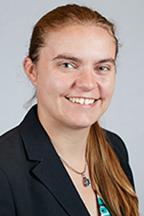Event
Inorganic Chemistry Seminar: Dr. Kathryn Knowles
"Synthesis and Photophysics of First-Row Transition Metal Oxide Semiconductor Nanomaterials"

Dr. Kathryn Knowles
University of Rochester
"Synthesis and Photophysics of First-Row Transition Metal Oxide Semiconductor Nanomaterials"
-Metal oxide nanomaterials based on first-row transition metals are particularly attractive for applications in renewable energy technologies because (i) they absorb visible light, (ii) they are thermodynamically capable of performing desired photoredox chemistry, such as water oxidation and reduction of protons or carbon dioxide, and (iii) they are composed of inexpensive, earth-abundant, nontoxic elements. Complete synthetic control of the size, shape, and crystal structure of first-row transition metal oxide nanomaterials combined with a thorough understanding of their electrochemical and photophysical behavior is required to optimize their function in photocatalytic applications. This talk focuses on recent results from two ongoing areas in our group. The first area investigates the role of organic ligands, solvent, and precursor chemistry in controlling the size, shape, composition, and crystal phase of first-row transition metal oxide nanocrystals synthesized at elevated pressure using solvothermal methods. The second project combines thermal difference and resonance Raman spectroscopy with DFT calculations to explore the dynamics and electronic structure of photoexcited states of nanostructured thin films of a-Fe2O3 (hematite). These data indicate that polarons (quasiparticles that comprise a charge-carrier self-trapped in a potential well formed by nuclear displacements of the surrounding lattice) form directly upon photoexcitation of a thermally activated lattice. This newly recognized mechanism of photoinduced polaron formation has significant implications for the use of hematite in light-conversion technologies such as photoelectrochemical water oxidation.
Biography
Kathryn Knowles completed undergraduate studies in chemistry and mathematics at the University of Rochester and earned a Ph.D. in chemistry from Northwestern University under the direction of Professor Emily Weiss with the support of a graduate research fellowship from the U.S. Department of Energy's Office of Science. She worked as a postdoctoral research associate in Prof. Daniel Gamelin's group at the University of Washington before returning to Rochester as an Assistant Professor of Chemistry in 2016. Throughout her career, Prof. Knowles's research has focused on studying inorganic nanomaterials that can convert light to energy in the form of electricity or fuels and characterizing the fundamental photophysical mechanisms that underpin these light conversion processes. Her work has been supported by a DOE Energy Efficiency and Renewable Energy (EERE) Postdoctoral Research Award, an ACS Petroleum Research Fund Doctoral New Investigator Award, and a National Science Foundation early CAREER award. She is also a Scialog Fellow for Negative Emissions Sciences.
Research Overview
Research in the Knowles group seeks to develop fundamental understanding of the synthesis, chemistry, electrochemistry, and photophysics of metal oxide semiconductor nanomaterials. Metal oxide semiconductors are a richly diverse class of materials with optical, electronic, chemical, and magnetic properties that vary widely depending on composition and stoichiometry. We aim to contribute to rational strategies for improving the performance of these materials in applications related to solar energy capture and storage.
One of our primary goals is to understand structure-function relationships between the nanostructured morphology and surface chemistry of a metal oxide semiconductor film and its performance as a photoelectrode. In addition to studying nanostructured films fabricated by sol-gel and electrodeposition techniques, we also use colloidal metal oxide nanocrystals as dispersible model systems to study the inter-related impacts of size, shape, and surface chemistry on interfacial redox processes that occur in the dark and under illumination.
To enable these studies, we design and develop rational approaches to controlling the size and shape of metal oxide nanocrystals synthesized by solvothermal methods and explore new single-source molecular precursors that will enable synthesis of previously inaccessible metal oxide crystal phases under ambient pressure. We are particularly interested in developing new synthetic strategies to access ternary metal oxide nanocrystals that have desirable optical, electronic, and chemical properties but are difficult to synthesize in colloidal form. In all of these synthetic projects, we strive to understand the mechanisms by which precursors convert to nanocrystal monomers and monomers nucleate to form nanocrystals.
Students in the Knowles group gain interdisciplinary experience at the interfaces of physical, inorganic, and materials chemistry. In addition to standard techniques for characterization of solution-phase and nanostructured inorganic materials (i.e. electron microscopy, X-ray diffraction, and NMR, infrared, electronic absorption, Raman, and photoluminescence spectroscopy), the core techniques used in our lab include spectroelectrochemistry, photoconductivity, reflectance spectroscopy, and time-resolved optical spectroscopies
https://www.sas.rochester.edu/chm/groups/knowles/
HOST: Goldberg
